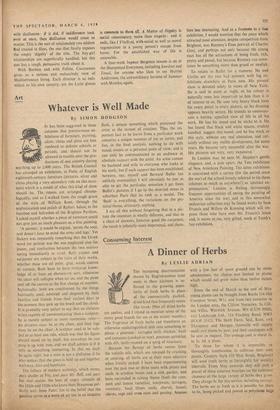Art
Whatever is Well Made
By SIMON
HODGSON
IT has been suggested in these columns that portmanteau ex- hibitions of furniture, painting, silyer, china and glass are best confined to definite schools or periods, and should not . be allowed to ramble over the pro- ductions of one country during anything up to 2,000 years. The British Council has arranged an exhibition, in Paris, of English eighteenth-century furniture (pictures, silver and china, playing a very secondary role on this occa- sion) which is a model of what this kind of show should be. The rooms are arranged chrono- logically, and as I walked from the rough grace of the style of William Kent, 'through the sophistication and polish of Rpbert Adam, to the bamboo and bulrushes of the Brighton Pavilion, I asked myself whether a piece of furniture could not give just as much pleasure as a fine painting.
'A painter,' it would be argued, 'paints the soul, and doesn't have to mind the arms and legs.' Yet Sickert was constantly remarking that the Greek word for painter was the one employed also for joiner, and similarities between the two metiers spring immediately to mind. Both painter and carpenter are subject to the rules of their media, whether these are oil paint. glue, wood, canvas or varnish. Both have to have technical know- ledge of at least an elementary sort, otherwise the chair will collapse when sat on, and the paint peel ofi• the canvas at the first change of weather. Stylistically, both are conditioned by the things habitually used,• admired and despised by their families and friends from their earliest days to the moment they pick up the brush and the chisel. It is probably very unfair to say that an einsiziste is less capable of 'communicating' than a sculptor; he is merely subject to more numerous rules— six drawers must be in the chest, and four legs miry/ be on the chair. A sculptor used to be sub- ject to at least one rule, which was that his figure should stand up by itself, but nowadays he can prop it up with iron, and we shall admire it if it tells us something interesting. In this we shall be quite right, but a man is not a philistine if he also notices that the piece is held up and together with wax, wire and bootlaces.
The fallacy of modern xsthetiss, which stems, pace shades of Fry, and pace Mr. Bell, and pace for that matter the host of angry colonels of the 1910s and 1920s who knew their Brasenose per- fectly well, from Pater, lies in the belief that the positive virtue in a work of art lies in an intuitive flash, a unique something which possessed the artist at the instant of creation. Thus the im- portant fact to be learnt from a particular work concerns a unique moment of joy or terror, and has, in the final analysis, nothing to do with mood, events or is personal point of view; and it can only be communicated to an audience in absolute rapport with the artist. An artist cannot be husband and wife to everyone who looks at his work; but if such rapport has been established between, say, myself and Bernard Buffet (an unlikely eventuality) I will obviously be just as able to get the particular sensation 1 get from Buffet's pictures if I go to the deserted street in suburban Paris that he took as a model. The 'flash' is everything, the variations on the pic- torial theme, ultimately, nothing.
I say all this without forgetting that in a pic- ture the intention is wholly different, and that in a chest of drawers, however good the carpenter, the result is infinitely more impersonal, and there- fore less interesting. And as a footnote to a fine exhibition, I would mention that the piece which attracted most attention, despite competition from Brighton, was Romney's Eton portrait of Charles Grey, and perhaps not only because the young man has all the attractions of being fresh, rich, pretty and proud, but because Romney can some- times be something more than grand or modish.
To return to Buffet for a moment. He and Utrillo are the two bad painters with big ex- hibitions elsewhere in Paris now. His present show is devoted solely to views of New York. He is said to paint at night, so his colour is naturally even less important to him than it is of interest• to us. He uses very heavy black lines for every detail in every picture, so his drawing appears heavily secure. He intends to communi- cate a barren, appalled view of life in all his work. He has his mood and he sticks to it. He has found that black and white spaces, crudely handled, suggest this mood, and he has stuck to this style, without any real alteration, and cer- tainly without any visible development, for some years. He became very successful after the war. His pictures are very, very expensive.
In London may be seen M. Hayden's gentle elegance, and, a pole apart, the Tate exhibition of New American Painting. The latter exhibition is concerned with a survey (for the period since the war) of the school loosely referred to (in these columns as much as anywhere!) as 'abstract ex- pressionism.' London is finding increasingly frequent opportunities of seeing the painting of America since the war, and in this somewhat pedestrian collection may be found works by Sam Francis and Willem de Kooning which will im- press those who have seen Mr. Francis's latest and, it seems to me, very gifted, work at Tooth's last exhibition.


































 Previous page
Previous page